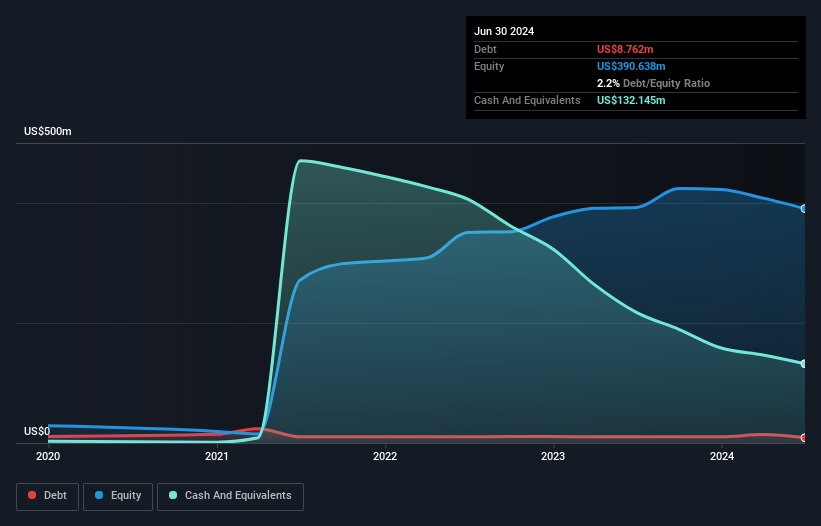- United States
- /
- Chemicals
- /
- NasdaqCM:ORGN
Does Origin Materials (NASDAQ:ORGN) Have A Healthy Balance Sheet?
Howard Marks put it nicely when he said that, rather than worrying about share price volatility, 'The possibility of permanent loss is the risk I worry about... and every practical investor I know worries about.' When we think about how risky a company is, we always like to look at its use of debt, since debt overload can lead to ruin. As with many other companies Origin Materials, Inc. (NASDAQ:ORGN) makes use of debt. But the real question is whether this debt is making the company risky.
When Is Debt A Problem?
Debt is a tool to help businesses grow, but if a business is incapable of paying off its lenders, then it exists at their mercy. In the worst case scenario, a company can go bankrupt if it cannot pay its creditors. However, a more usual (but still expensive) situation is where a company must dilute shareholders at a cheap share price simply to get debt under control. Having said that, the most common situation is where a company manages its debt reasonably well - and to its own advantage. The first step when considering a company's debt levels is to consider its cash and debt together.
Check out our latest analysis for Origin Materials
What Is Origin Materials's Net Debt?
You can click the graphic below for the historical numbers, but it shows that Origin Materials had US$8.76m of debt in June 2024, down from US$10.3m, one year before. However, its balance sheet shows it holds US$132.1m in cash, so it actually has US$123.4m net cash.

How Healthy Is Origin Materials' Balance Sheet?
Zooming in on the latest balance sheet data, we can see that Origin Materials had liabilities of US$11.9m due within 12 months and liabilities of US$28.5m due beyond that. Offsetting these obligations, it had cash of US$132.1m as well as receivables valued at US$20.0m due within 12 months. So it can boast US$111.8m more liquid assets than total liabilities.
This excess liquidity is a great indication that Origin Materials' balance sheet is almost as strong as Fort Knox. Having regard to this fact, we think its balance sheet is as strong as an ox. Succinctly put, Origin Materials boasts net cash, so it's fair to say it does not have a heavy debt load! The balance sheet is clearly the area to focus on when you are analysing debt. But ultimately the future profitability of the business will decide if Origin Materials can strengthen its balance sheet over time. So if you're focused on the future you can check out this free report showing analyst profit forecasts.
Over 12 months, Origin Materials reported revenue of US$34m, which is a gain of 296%, although it did not report any earnings before interest and tax. That's virtually the hole-in-one of revenue growth!
So How Risky Is Origin Materials?
Statistically speaking companies that lose money are riskier than those that make money. And we do note that Origin Materials had an earnings before interest and tax (EBIT) loss, over the last year. And over the same period it saw negative free cash outflow of US$89m and booked a US$13m accounting loss. Given it only has net cash of US$123.4m, the company may need to raise more capital if it doesn't reach break-even soon. The good news for shareholders is that Origin Materials has dazzling revenue growth, so there's a very good chance it can boost its free cash flow in the years to come. High growth pre-profit companies may well be risky, but they can also offer great rewards. When analysing debt levels, the balance sheet is the obvious place to start. But ultimately, every company can contain risks that exist outside of the balance sheet. For example, we've discovered 4 warning signs for Origin Materials (1 shouldn't be ignored!) that you should be aware of before investing here.
At the end of the day, it's often better to focus on companies that are free from net debt. You can access our special list of such companies (all with a track record of profit growth). It's free.
New: AI Stock Screener & Alerts
Our new AI Stock Screener scans the market every day to uncover opportunities.
• Dividend Powerhouses (3%+ Yield)
• Undervalued Small Caps with Insider Buying
• High growth Tech and AI Companies
Or build your own from over 50 metrics.
Have feedback on this article? Concerned about the content? Get in touch with us directly. Alternatively, email editorial-team (at) simplywallst.com.
This article by Simply Wall St is general in nature. We provide commentary based on historical data and analyst forecasts only using an unbiased methodology and our articles are not intended to be financial advice. It does not constitute a recommendation to buy or sell any stock, and does not take account of your objectives, or your financial situation. We aim to bring you long-term focused analysis driven by fundamental data. Note that our analysis may not factor in the latest price-sensitive company announcements or qualitative material. Simply Wall St has no position in any stocks mentioned.
About NasdaqCM:ORGN
Adequate balance sheet with slight risk.
Market Insights
Community Narratives



